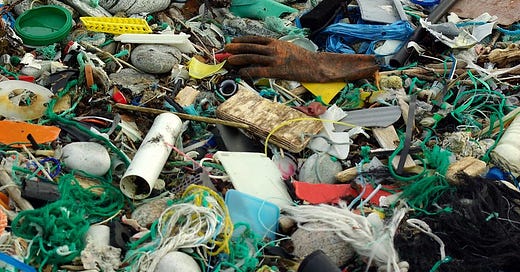Our Immortal Plastics | 9 | Magnitude
How do we climb down from our current dizzying heights of plastic use?
A layer of colourful plastic trash on the shoreline. Photo by Snemann, used under Creative Commons license.
I’ve been grappling lately with the magnitude of our plastic’s role in our lives, both welcome or otherwise.
I’d like to think that we are at, or approaching, Peak Plastic. That after this year or next plastic production (or at least the production of new, virgin plastics from fossil fuels) will start declining. But that’s not our reality.
Instead, plastic production has increased because of the pandemic, and is unlikely to decrease substantially until it is over.
Stockpiling supplies meant an increase in plastic packaging. Efforts to increase personal protective equipment supplies meant even more single-use plastic gloves, masks, bags and wrappers. Even lumber prices played a role as people bought plastic planks and shed siding instead of pricey wood. The price of plastic resin has gone up to match the increased demand.
The solutions being floated by activists and entrepreneurs share common themes: ban single-use consumer plastic, tax its use and mandate extended producer responsibility so plastic producers design their products with a second and third “life” in mind.
Only governments can make these changes, if there is popular will for them.
With the end of our last election, Canada once again has a minority Liberal government, which will hopefully take steps to live up to its promises on plastics. To refresh your memory (and mine), its election promises were:
Create a single-use plastics ban, going into effect at the end of 2021 (which currently only includes grocery checkout bags, straws, six-pack rings, plastic cutlery and food takeout containers)
Establish a federal public registry for producers to annually report the amount, type and end-of-life management for plastics in Canada.
Invest $50 million over the next 5 years to support community shoreline and oceans plastic cleanup.
Require that all plastic packaging in Canada contain at least 50% recycled content, by 2030.
Work with provinces and territories to create and enforce an “ambitious recycling target for plastic beverage bottles”
Several of those promises are interesting, such as the single-use plastics ban and the promise of a federal public registry that plastic producers would report to.
I’m also intrigued to see how the Liberals plan to enforce a beverage bottle recycling target when the economics of recycling plastic bottles are so bad. There’s so little value in food-tainted consumer plastic that recycling plants can’t make a profit by recycling them. Until recently we shipped that plastic trash overseas to China and elsewhere. Would the federal government have to subsidize recycling plants with public money to make this work?
It seems much more likely that the Liberals will put this difficult pledge on the backburner and plead for more time at the next election.
Overall, I’m still encouraged that pressure for solutions to our plastic problem is steadily building, with noticeable effects on public policy. We just have to be sure the solutions offered will actually be effective.
Your plastic reads for the week:
The Revelator - How to turn off the tap on plastic waste
CBC News - Floating garbage bins help collect trash from Vancouver’s waterways
CBC News - Industrial plastic is spilling into Great Lakes, and no one’s regulating it, experts warn
Global News - Plastic resins face supply crunch as prices skyrocket amid Covid-19
WHBL - Indonesian museum made from plastic bottles and bags highlights marine crisis
El Pais - Spain to ban sale of fruit and vegetables in plastic wrapping from 2023
Thanks for following along, dear reader.
I’d like to end this entry with a question. How does plastic use and plastic pollution affect your daily life? Is there something plastic-related in your life you’d like to see changed?
Please send me your responses. I love hearing from readers of this newsletter.
Thanks,
Cullen



